Matcha
Matcha vs Coffee Caffeine: Energy Battle Unveiled
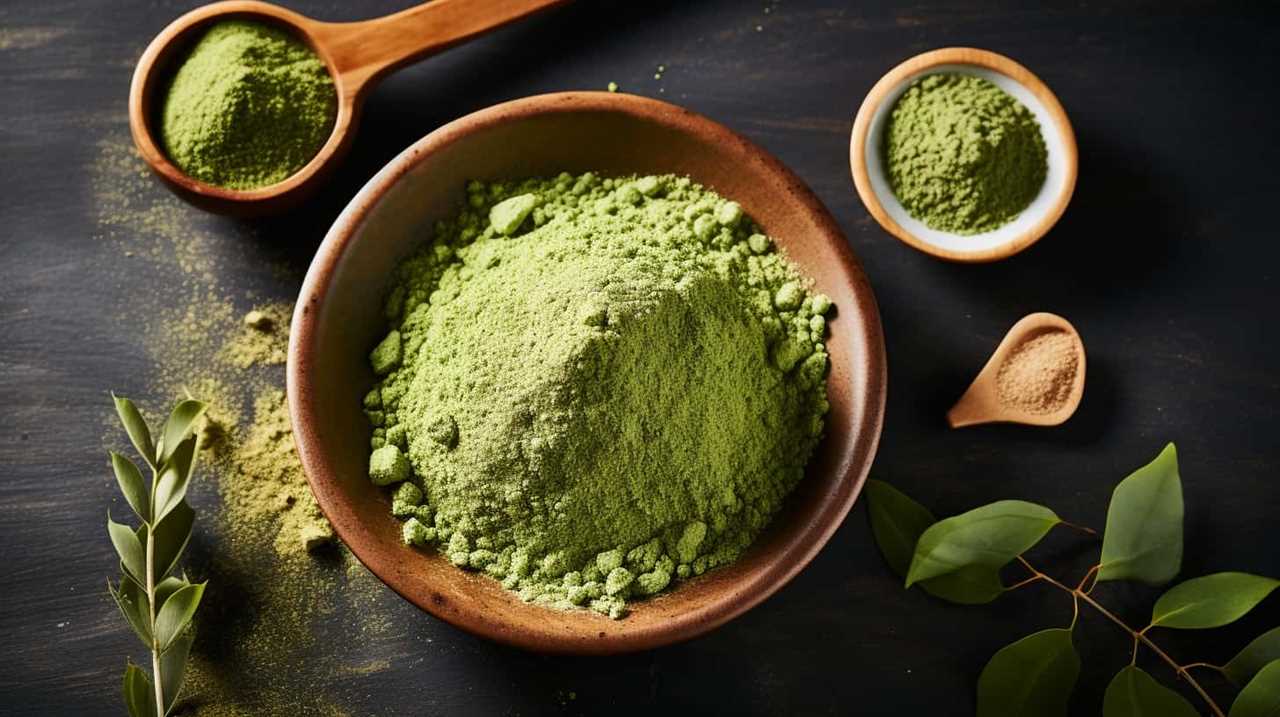
When it comes to fueling our mornings, many of us turn to either matcha or coffee for that much-needed caffeine boost. But which one packs a stronger punch? Let’s delve into the world of matcha vs coffee caffeine and unravel the mystery.
Picture this: you have a big presentation at work and need a boost of energy to stay focused and alert. Would a cup of matcha or a steaming mug of coffee be your go-to choice? In this article, we will explore the caffeine content, absorption rates, and potential health benefits of both matcha and coffee, so that you can make an informed decision on which one suits your needs best.
Key Takeaways
- Matcha and coffee both offer unique health benefits, with matcha containing high concentrations of catechins and antioxidants that protect against free radicals.
- Matcha provides a more sustained release of energy compared to coffee, resulting in improved focus and mental clarity.
- Matcha’s production process increases its antioxidant benefits, and its catechins, especially EGCG, have been linked to reducing the risk of chronic diseases.
- Taste and preference also play a significant role in the choice between matcha and coffee.
Understanding Caffeine: The Basics
Let’s start by exploring the basics of caffeine and its effects on our bodies. Caffeine is a natural stimulant that’s found in various foods and beverages, including coffee and matcha. When consumed, caffeine is rapidly absorbed into the bloodstream and can reach peak levels within 30 to 60 minutes. The absorption rate can vary depending on factors such as individual metabolism and the form of caffeine consumed.
When it comes to health benefits, both matcha and coffee offer unique advantages. Matcha, a powdered green tea, contains a compound called L-theanine that promotes relaxation and mental clarity. Additionally, matcha provides a sustained release of caffeine, leading to a more gradual and longer-lasting energy boost. On the other hand, coffee contains antioxidants and has been associated with numerous health benefits, such as improved cognitive function and a reduced risk of certain diseases.
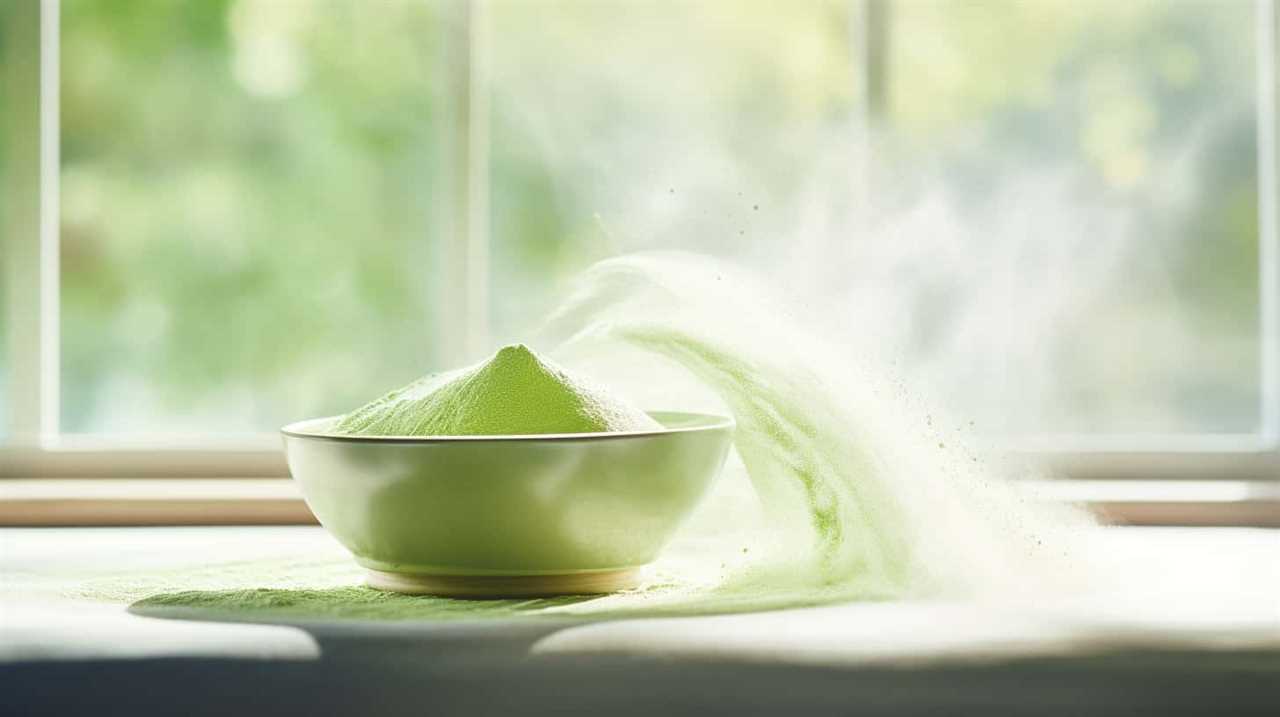
Now that we’ve examined the basics of caffeine and its absorption as well as the health benefits of matcha and coffee, let’s delve into the origins of these two popular beverages.
The Origins of Matcha and Coffee
When examining the origins of matcha and coffee, it’s important to consider their historical roots and cultural significance.
Matcha, a powdered form of green tea, originated in China during the Tang Dynasty and was later introduced to Japan in the 12th century. It has since become an integral part of Japanese tea ceremonies and is highly valued for its ceremonial and health benefits.
Coffee, on the other hand, has a rich history rooted in Ethiopia, where it was first discovered and cultivated. It spread to the Arabian Peninsula and eventually made its way to Europe, becoming a popular beverage worldwide.
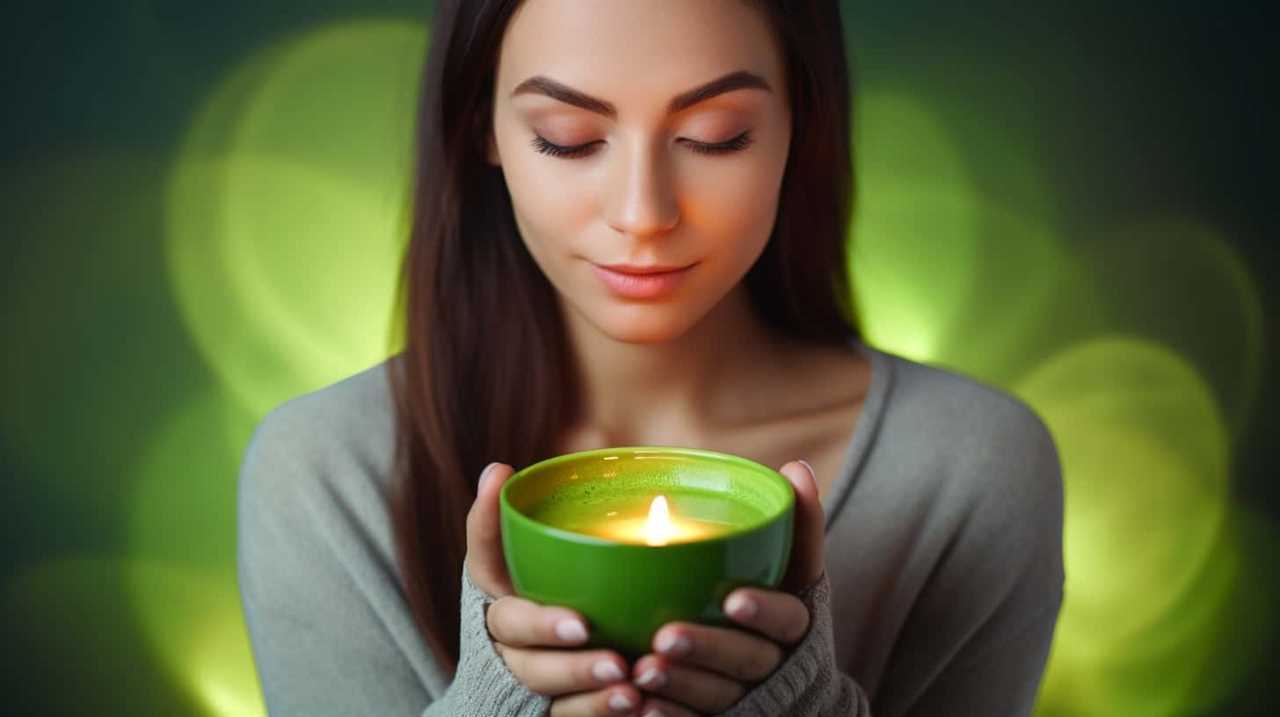
Understanding the historical origins and cultural significance of matcha and coffee provides valuable context for analyzing their differences and effects on the body.
Historical Origins of Matcha and Coffee
The historical origins of matcha and coffee can be traced back to distinct regions and cultures. Both beverages have undergone a fascinating historical evolution, with each drink finding its roots in different parts of the world.
- Matcha:
- Originated in China during the Tang Dynasty (7th-10th centuries)
- Later introduced to Japan in the 12th century by Buddhist monks
- Became an integral part of Japanese tea ceremonies, symbolizing purity, tranquility, and mindfulness
- Coffee:
- Originated in Ethiopia in the 9th century
- Spread to the Arabian Peninsula, where it gained popularity and was cultivated on a larger scale
- Associated with socializing, stimulating conversation, and energizing the mind
Understanding the historical context of matcha and coffee provides valuable insights into their cultural symbolism and significance.
Transitioning into the next section, we’ll explore the cultural significance of these two beverages in more detail.
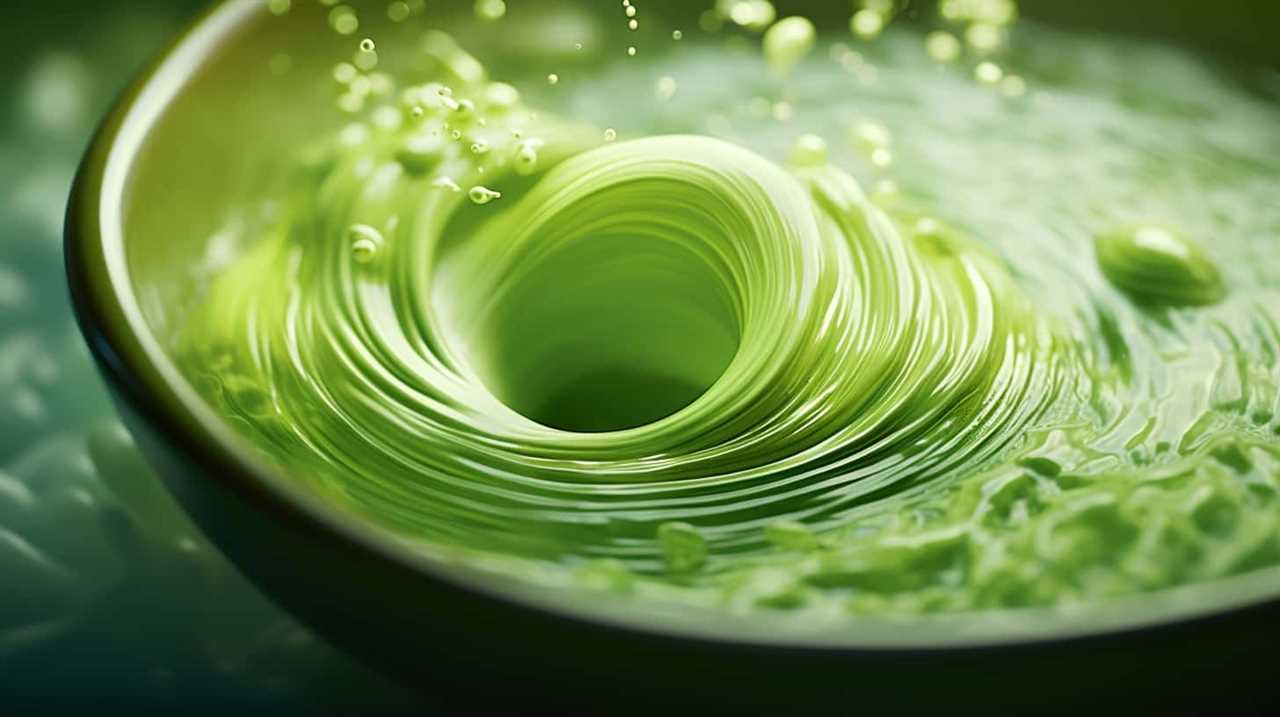
Cultural Significance of Matcha and Coffee
Continuing from our exploration of the historical origins of matcha and coffee, let us now delve into the cultural significance of these two beverages, specifically focusing on their origins. Matcha and coffee have both played important roles in the cultures of their respective countries for centuries. Matcha, a powdered green tea, has been an integral part of traditional Japanese tea ceremonies since the 12th century. It is deeply rooted in Zen Buddhism and is associated with mindfulness and tranquility. On the other hand, coffee has a rich history in the Middle East and Africa, where it has been enjoyed for its stimulating properties. Coffeehouses have long served as hubs of intellectual and social gatherings, fostering creativity and conversation.
To better understand the cultural significance of matcha and coffee, let us examine the health benefits associated with each beverage:
| Matcha | Coffee |
|---|---|
| Rich in antioxidants | High caffeine content |
| Boosts metabolism | Increases alertness |
| Enhances focus and concentration | Improves physical performance |
Both matcha and coffee have their unique cultural significance and offer various health benefits. Whether you prefer the calming and meditative qualities of matcha or the energizing effects of coffee, these beverages have become a part of our daily rituals and contribute to our overall well-being.
How Caffeine Content Is Measured
To understand how caffeine content is measured, it’s important to consider the methods used for determining the amount of caffeine present in both matcha and coffee. Caffeine measurement techniques involve precise analytical methods that allow for accurate quantification of caffeine content. Here are three subtopics that shed light on this process:
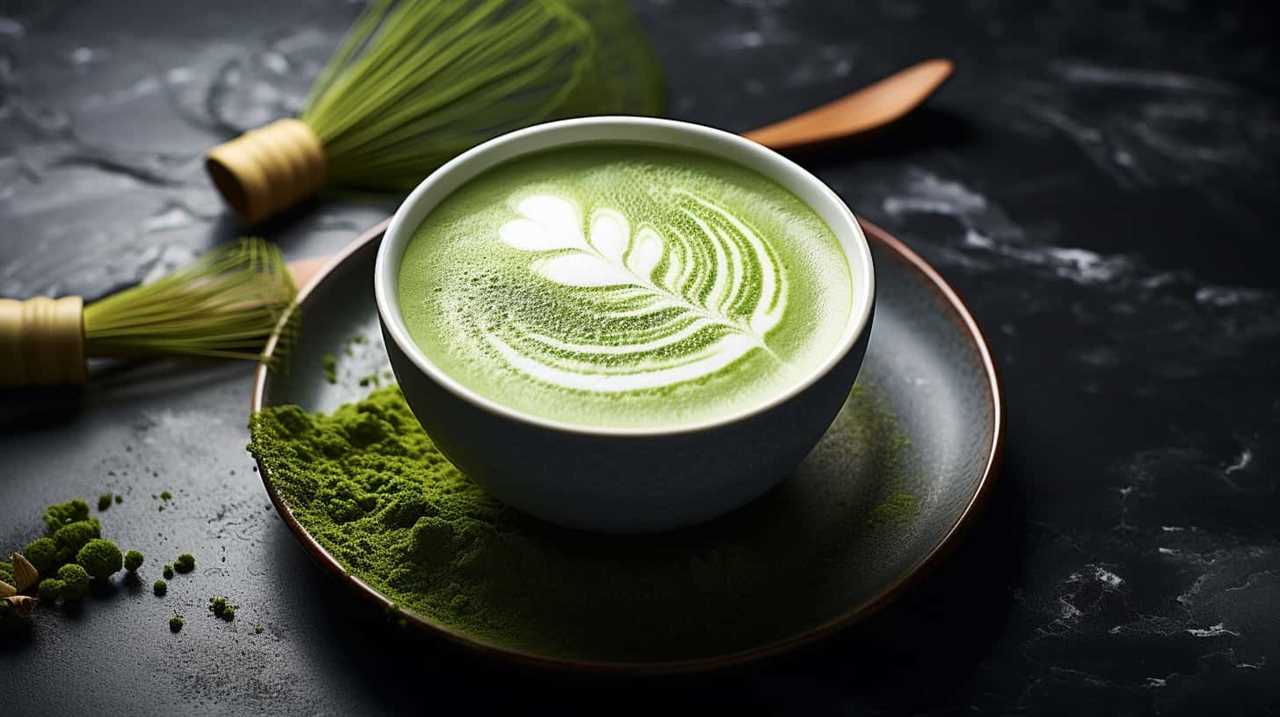
- High-performance liquid chromatography (HPLC): This widely used method separates and quantifies caffeine molecules based on their interactions with a stationary phase and mobile phase, providing accurate results.
- Spectrophotometry: This method measures the absorption of light by caffeine molecules, allowing for the determination of caffeine concentration.
- Enzymatic assays: These assays utilize enzymes that specifically interact with caffeine, enabling the measurement of caffeine content.
It is worth noting that caffeine content variations can occur due to factors like brewing time, temperature, and the source of coffee or matcha. Understanding these measurement techniques helps us comprehend the caffeine content of matcha and coffee accurately, ensuring informed choices for those seeking mastery in their caffeine consumption.
The Caffeine Content of Matcha
How much caffeine do we find in matcha compared to coffee?
Matcha, a powdered form of green tea, contains a moderate amount of caffeine, but it’s lower than that found in coffee. On average, a cup of matcha contains approximately 70 milligrams of caffeine, while a cup of coffee contains around 95 milligrams.
However, the caffeine in matcha is known to have a different effect on the body compared to coffee due to its interaction with other compounds. Matcha contains L-theanine, an amino acid that promotes relaxation and reduces the jittery effects of caffeine.

This combination of caffeine and L-theanine in matcha promotes a more calm and focused energy, as opposed to the sudden spike and crash often associated with coffee. Furthermore, the slower absorption of caffeine in matcha can lead to sustained energy levels and a more gradual caffeine release throughout the day.
The Caffeine Content of Coffee
Moving on to coffee, let’s now explore its caffeine content in comparison to matcha.
Coffee is widely known for its high caffeine content, making it a popular choice for those seeking an energy boost. Here are three key points to consider:
- Caffeine Content: Coffee typically contains more caffeine than matcha. On average, an 8-ounce cup of brewed coffee contains around 95 milligrams of caffeine, while the same amount of matcha contains about 30 milligrams.
- Caffeine Metabolism: Caffeine in coffee is rapidly absorbed into the bloodstream and reaches peak levels within 30-60 minutes. Its effects can last for several hours. Individual caffeine metabolism may vary, affecting how quickly caffeine is broken down in the body.
- Caffeine Withdrawal: Regular coffee drinkers may experience withdrawal symptoms when reducing or discontinuing their caffeine intake, such as headaches, fatigue, and irritability.
Understanding the caffeine content of coffee is crucial when comparing it to matcha. Let’s now delve into the factors that can affect caffeine levels in both matcha and coffee.

Transitioning to the subsequent section, let’s explore the factors that can influence the caffeine levels in both matcha and coffee.
Factors Affecting Caffeine Levels in Matcha and Coffee
Continuing our exploration, let’s now examine the factors that can impact the levels of caffeine in both matcha and coffee.
Several factors influence the amount of caffeine absorbed from these beverages, including the method of preparation, brewing time, and water temperature. For matcha, the quality of the tea leaves and the concentration of the powder can also affect caffeine levels.
Additionally, individual differences in caffeine metabolism rate play a crucial role. Some people have a genetic variation that affects the activity of enzymes responsible for caffeine metabolism, resulting in slower or faster clearance of caffeine from the body. Furthermore, factors like age, weight, and overall health can influence caffeine absorption rates.
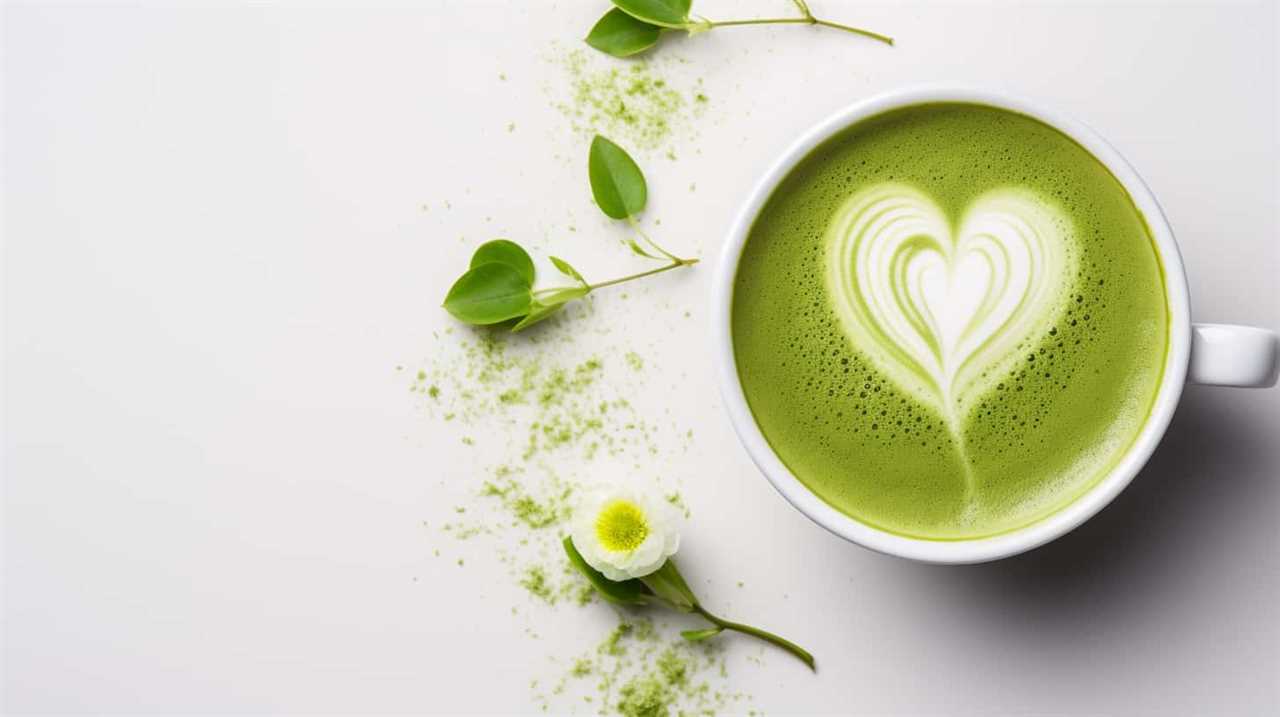
Understanding these factors is essential for individuals who desire mastery in managing their caffeine intake and optimizing their energy levels.
Caffeine Absorption and Effects on the Body
To delve further into the comparison between matcha and coffee caffeine, let’s now explore how caffeine is absorbed by the body and its effects. Understanding caffeine metabolism is crucial in understanding its effects on the body. Here are three key points to consider:
- Absorption: Caffeine is rapidly absorbed through the gastrointestinal tract and reaches peak levels in the bloodstream within 30 to 60 minutes after consumption. This makes it readily available for the body to utilize.
- Metabolism: The liver is responsible for metabolizing caffeine. It breaks it down into three primary metabolites, namely paraxanthine, theobromine, and theophylline. Each metabolite has unique effects on the body.
- Long-term effects: Regular caffeine consumption can lead to tolerance and dependence. It may also affect sleep patterns, increase heart rate, and cause gastrointestinal disturbances. However, the long-term effects of caffeine on health are still a topic of ongoing research.
Understanding how caffeine is absorbed and metabolized by the body provides insight into its potential effects. Now, let’s explore the health benefits of matcha and coffee.
Health Benefits of Matcha and Coffee
When comparing the health benefits of matcha and coffee, it’s important to consider the antioxidants present in matcha.
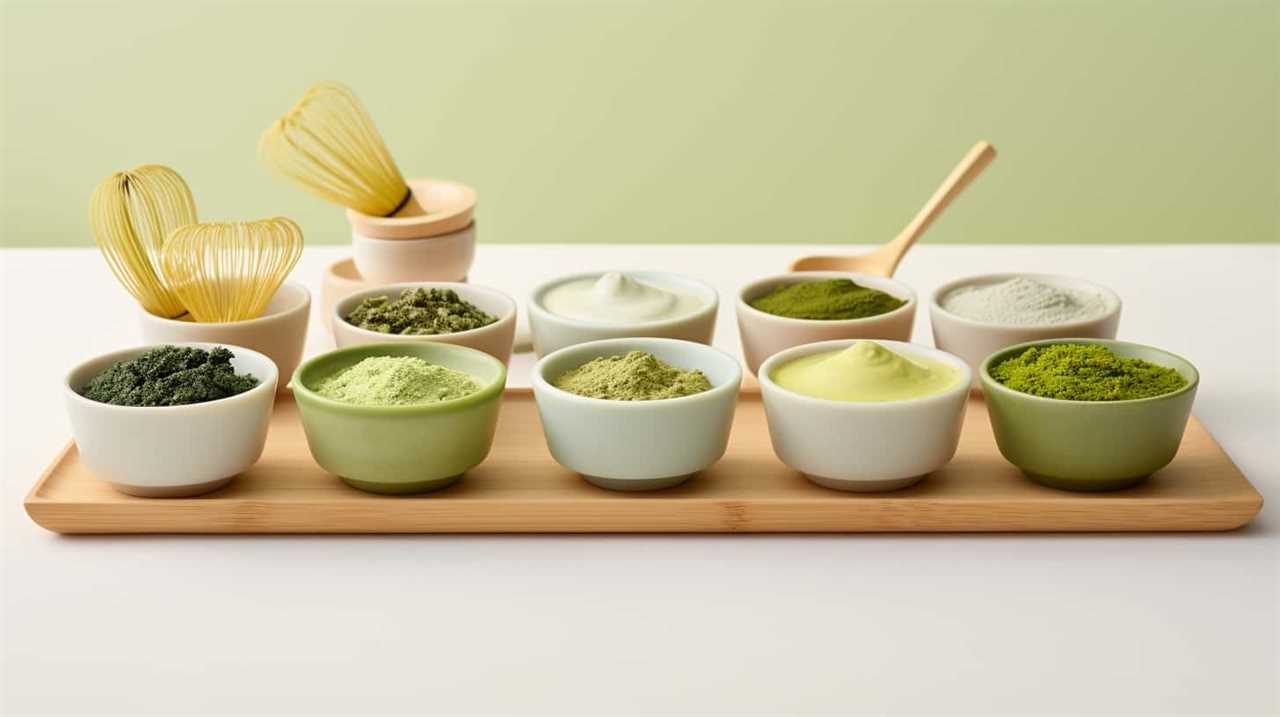
Matcha contains a high concentration of catechins, which are powerful antioxidants that help protect the body against damage from free radicals.
Additionally, matcha provides a more sustained release of energy compared to coffee, which can result in improved focus and mental clarity throughout the day.
Antioxidants in Matcha
Our research reveals that matcha contains a significant amount of antioxidants, enhancing our understanding of the health benefits of both matcha and coffee.
Antioxidants play a crucial role in protecting our cells from damage caused by free radicals, which can lead to various diseases and accelerate aging.
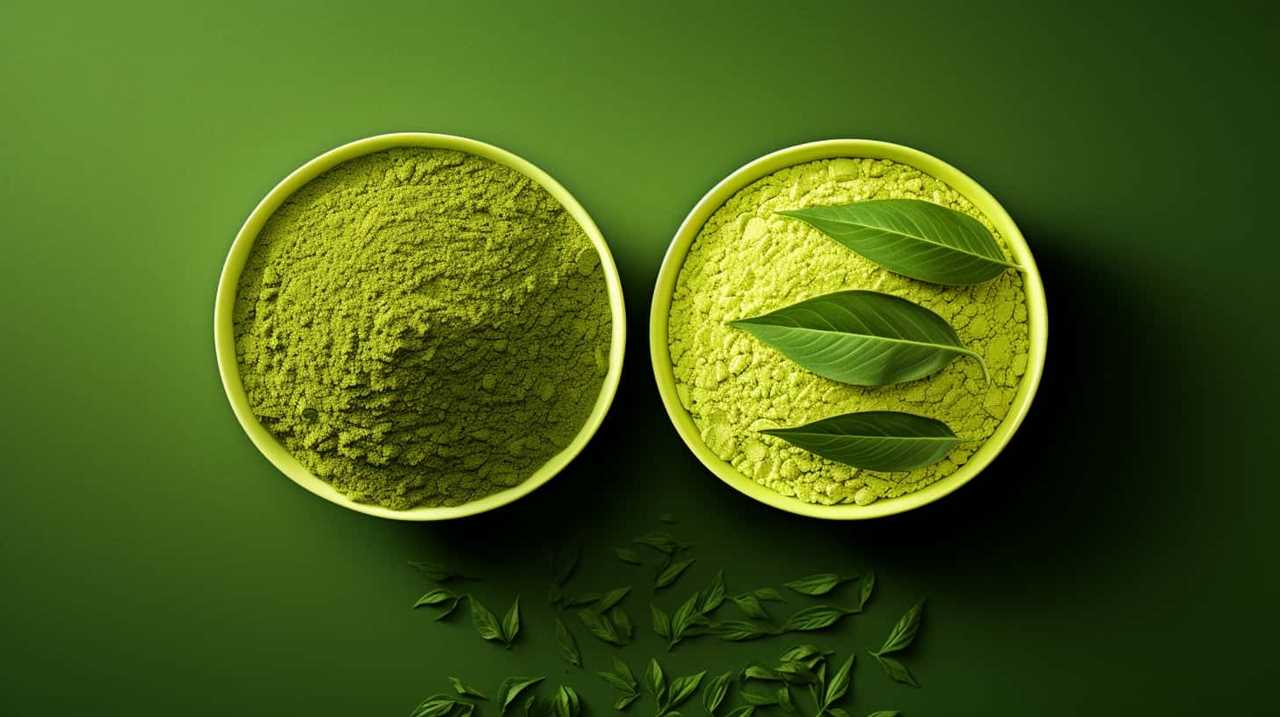
When it comes to matcha, the production process plays a key role in its antioxidant benefits. Matcha is made from shade-grown tea leaves, which increases the chlorophyll content and stimulates the production of antioxidants such as catechins.
These catechins, specifically epigallocatechin gallate (EGCG), are potent antioxidants that have been linked to numerous health benefits, including reducing the risk of chronic diseases like heart disease and certain types of cancer.
Additionally, matcha also contains other beneficial compounds like L-theanine, which can promote relaxation and mental clarity.
Energy Levels Comparison
In comparing the energy levels of matcha and coffee, we find that both beverages offer distinct health benefits. Caffeine is the primary source of energy in both matcha and coffee. However, the effects of caffeine metabolism differ between the two.
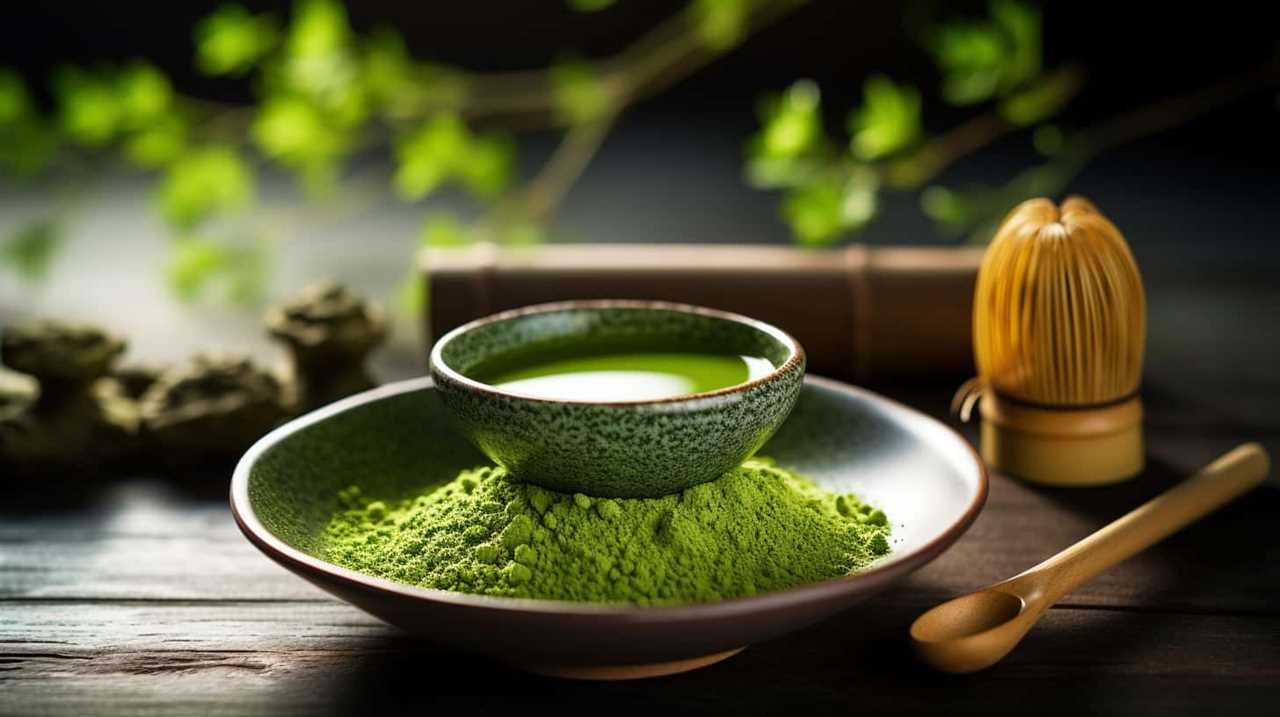
Matcha contains a lower amount of caffeine compared to coffee, but it also contains L-theanine, an amino acid that promotes relaxation and reduces the jitters commonly associated with caffeine. This combination results in a sustained release of energy, providing a more balanced and focused state of alertness.
Coffee, on the other hand, provides a quick energy boost due to its higher caffeine content. While both matcha and coffee can increase energy levels, it’s important to consider the long-term effects. Excessive coffee consumption may lead to caffeine dependency, whereas matcha offers a healthier alternative for sustained energy without the adverse effects.
Mental Focus Benefits
To further explore the health benefits of matcha and coffee, let’s delve into their mental focus benefits. Both matcha and coffee contain caffeine, which has been shown to have a positive effect on productivity and cognitive enhancement.
Here are three ways in which caffeine can improve mental focus:
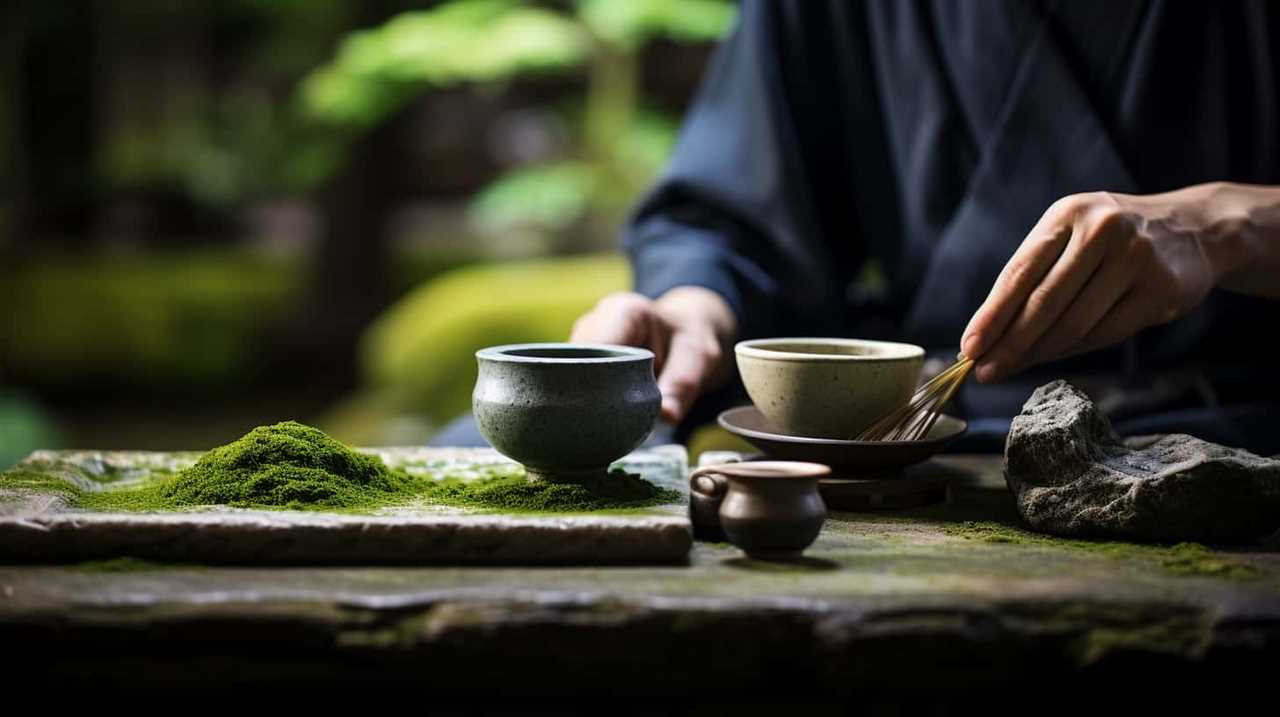
- Increased alertness: Caffeine stimulates the central nervous system, leading to increased alertness and a reduction in fatigue. This can enhance concentration and focus, allowing individuals to stay engaged and productive for longer periods of time.
- Improved attention: Studies have shown that caffeine can improve attention span and help individuals stay focused on tasks. It does this by blocking the action of adenosine, a neurotransmitter that promotes sleep and relaxation.
- Enhanced memory: Caffeine has been found to enhance memory consolidation, making it easier to retain and recall information. This can be particularly beneficial when studying or working on complex tasks that require the retention of large amounts of information.
Matcha Vs Coffee: Which Gives a Stronger Boost
We often find that matcha gives us a stronger boost than coffee. When comparing the caffeine content, matcha contains approximately 35 milligrams of caffeine per gram, while coffee typically contains 10 milligrams per gram.
This higher caffeine content in matcha can provide a more pronounced stimulant effect, leading to increased alertness and improved focus. Additionally, matcha contains L-theanine, an amino acid that has been shown to promote relaxation and reduce anxiety. This combination of caffeine and L-theanine in matcha can result in a more balanced and sustained energy boost, without the jitters or crash commonly associated with coffee consumption.
Furthermore, matcha is rich in antioxidants, which have numerous health benefits such as boosting the immune system and reducing the risk of chronic diseases.
Making the Choice: Matcha or Coffee?
When deciding between matcha and coffee, there are several factors to consider.
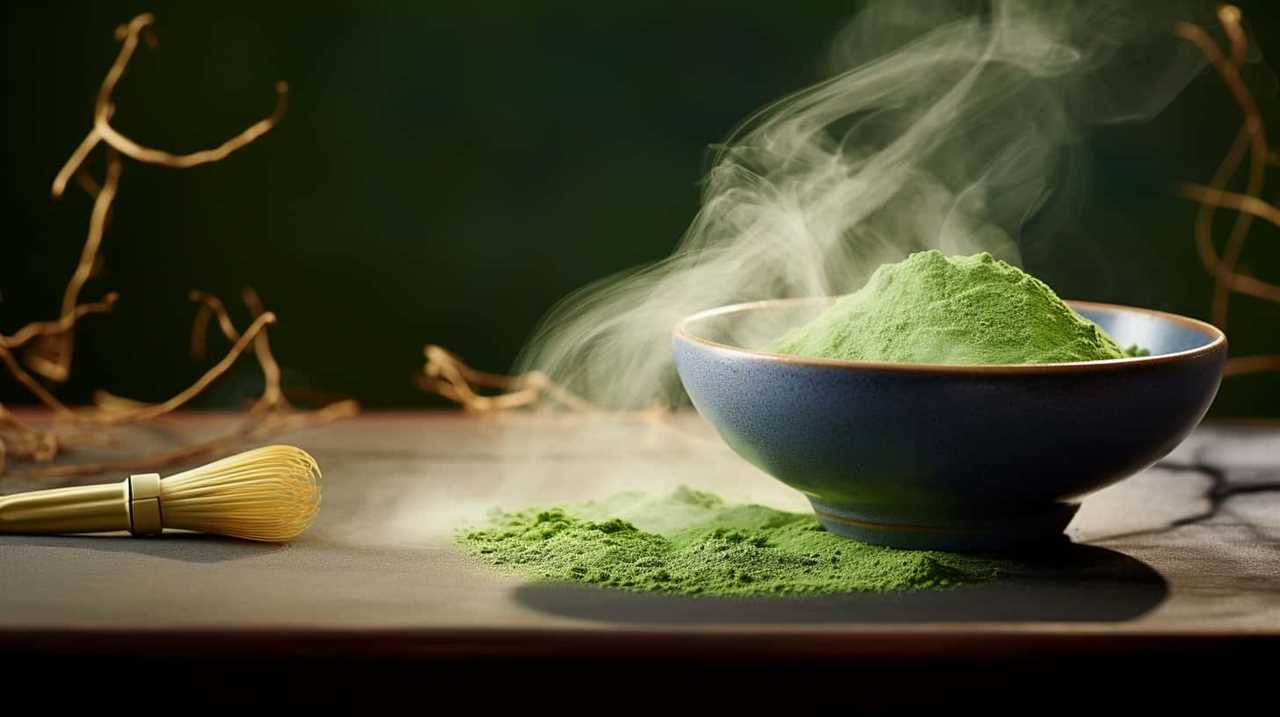
Firstly, the health benefits comparison is crucial, as matcha is packed with antioxidants while coffee provides a higher dose of caffeine.
Next, it’s important to take into account the impact on energy levels – matcha provides a more sustained and gentle boost, while coffee may result in a more immediate but shorter-lived burst of energy.
Lastly, taste and preference play a significant role, as individuals may have different preferences when it comes to the unique flavors of matcha and coffee.
Health Benefits Comparison
In the comparison of health benefits between matcha and coffee, we can weigh the advantages of each drink.

When considering caffeine metabolism, matcha provides a slower release of caffeine compared to coffee. This gradual release can result in sustained energy levels without the jitters or crash commonly associated with coffee consumption.
Additionally, matcha contains L-theanine, an amino acid that promotes relaxation and mental clarity, counteracting the potential side effects of caffeine such as anxiety and restlessness.
Furthermore, matcha is rich in antioxidants, specifically catechins, which have been linked to various health benefits including improved heart health and reduced risk of chronic diseases.
These factors make matcha a favorable choice for individuals seeking a healthier alternative to coffee.

Energy Levels Impact
For me, deciding between matcha and coffee comes down to the impact they have on my energy levels. As someone who values sustained and steady energy throughout the day, understanding the differences in caffeine metabolism and long-term effects is crucial. Let’s compare the two beverages in terms of their impact on energy levels.
| Matcha | Coffee | |
|---|---|---|
| Caffeine Content | 35 mg per serving | 95 mg per serving |
| Caffeine Metabolism | Slower release | Faster release |
| Energy Boost | Gentle and calm | Quick and intense |
| Long-Term Effects | Increased focus | Potential jitters |
Matcha contains less caffeine compared to coffee, providing a milder energy boost. Its slower release of caffeine results in a more sustained effect, avoiding the sudden crashes commonly associated with coffee. Additionally, matcha promotes increased focus without causing jitters. On the other hand, coffee delivers a quicker and more intense energy boost, but it may lead to potential jitters in some individuals. Considering caffeine metabolism and long-term effects, matcha’s gentle and calm energy boost makes it an appealing choice for those seeking sustained energy throughout the day.
Taste and Preference
As we consider the taste and preference when choosing between matcha and coffee, it’s important to delve further into our personal preferences and how they shape our beverage choices.
Taste preferences play a significant role in determining whether one prefers matcha or coffee. Some individuals enjoy the bold, bitter taste of coffee, while others prefer the smooth, earthy flavor of matcha.

Additionally, personal preferences can be influenced by cultural backgrounds and traditions. For instance, matcha is deeply rooted in Japanese culture and is often associated with tea ceremonies. On the other hand, coffee has become a staple in many Western societies.
Lastly, caffeine addiction can also impact taste preferences. Those who are more dependent on caffeine may lean towards coffee due to its higher caffeine content.
Understanding our taste preferences and considering factors such as culture and caffeine addiction can help us make an informed choice between matcha and coffee.
Frequently Asked Questions
Can Matcha and Coffee Be Consumed Together to Increase Caffeine Intake?
Combining matcha and coffee for a caffeine boost is a possible approach to increasing intake. Exploring the health benefits of matcha and coffee consumption reveals potential synergistic effects on mental alertness and focus.

Are There Any Negative Side Effects of Consuming High Amounts of Caffeine From Matcha or Coffee?
Consuming high amounts of caffeine from matcha or coffee can have negative effects on our health. Long-term intake may lead to sleep disturbances, increased heart rate, anxiety, and digestive issues. It’s important to moderate our caffeine consumption for optimal well-being.
Does the Caffeine Content in Matcha and Coffee Vary Depending on the Brand or Quality?
The caffeine content in matcha and coffee can vary depending on the brand or quality. When comparing caffeine levels, it is important to consider the impact of brand and quality on the final caffeine content.
Are There Any Differences in the Way the Body Absorbs and Metabolizes Caffeine From Matcha and Coffee?
There may be differences in the way our bodies absorb and metabolize caffeine from matcha and coffee. Factors such as caffeine absorption rate and metabolism rate can vary between individuals and may be influenced by various factors such as genetics and overall health. Further research is needed to fully understand these differences.
Can Matcha and Coffee Be Decaffeinated, and if So, Does the Process Affect the Taste and Health Benefits?
Decaffeination methods for matcha and coffee vary, but they can be achieved without compromising taste or health benefits. The process removes most of the caffeine, allowing us to enjoy these beverages without the jitters or sleep disturbances associated with caffeine consumption.
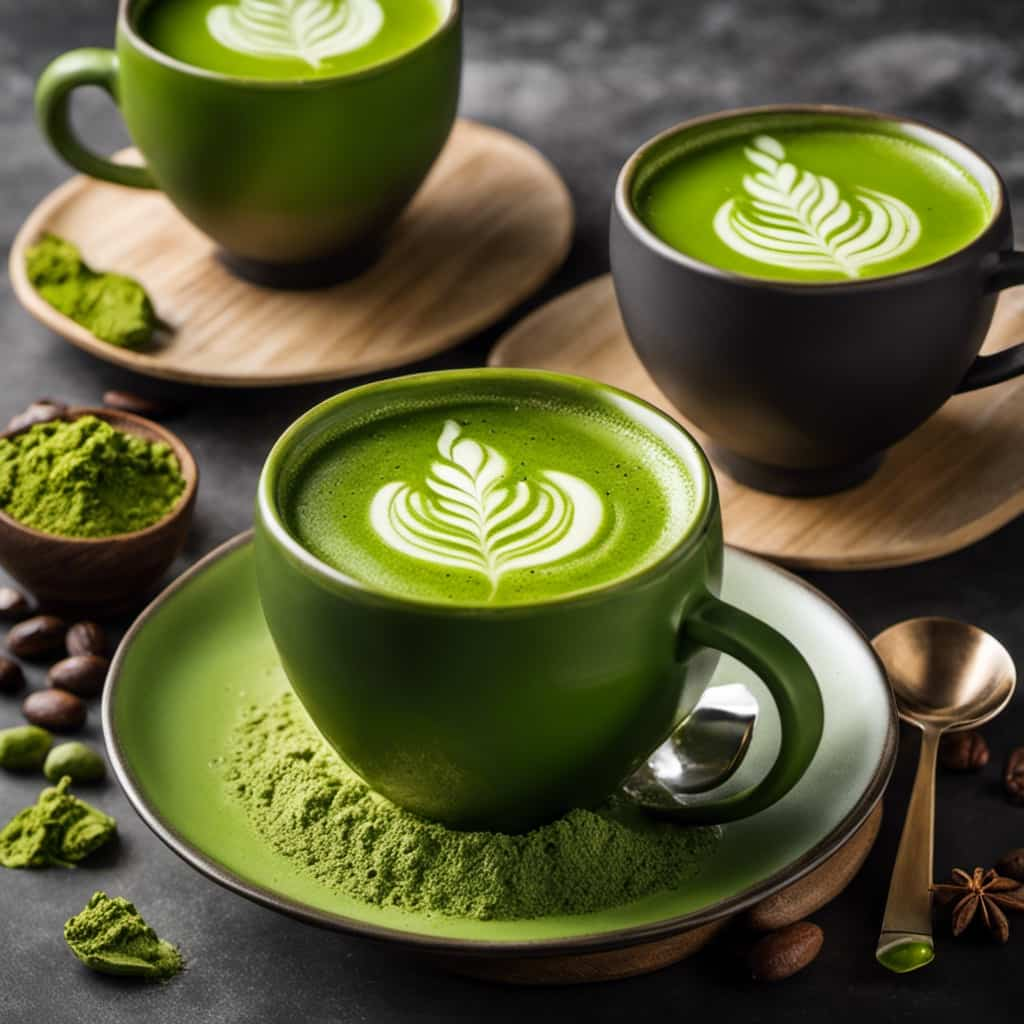
Conclusion
In conclusion, the choice between matcha and coffee ultimately depends on personal preference and desired effects.
Both beverages contain caffeine, but matcha provides a more sustained and steady energy boost due to its unique combination of caffeine and amino acids.
On the other hand, coffee offers a quicker jolt of caffeine but may lead to jitters and a crash later on.
Consider your own body’s reaction to caffeine and choose the beverage that best suits your needs and preferences.
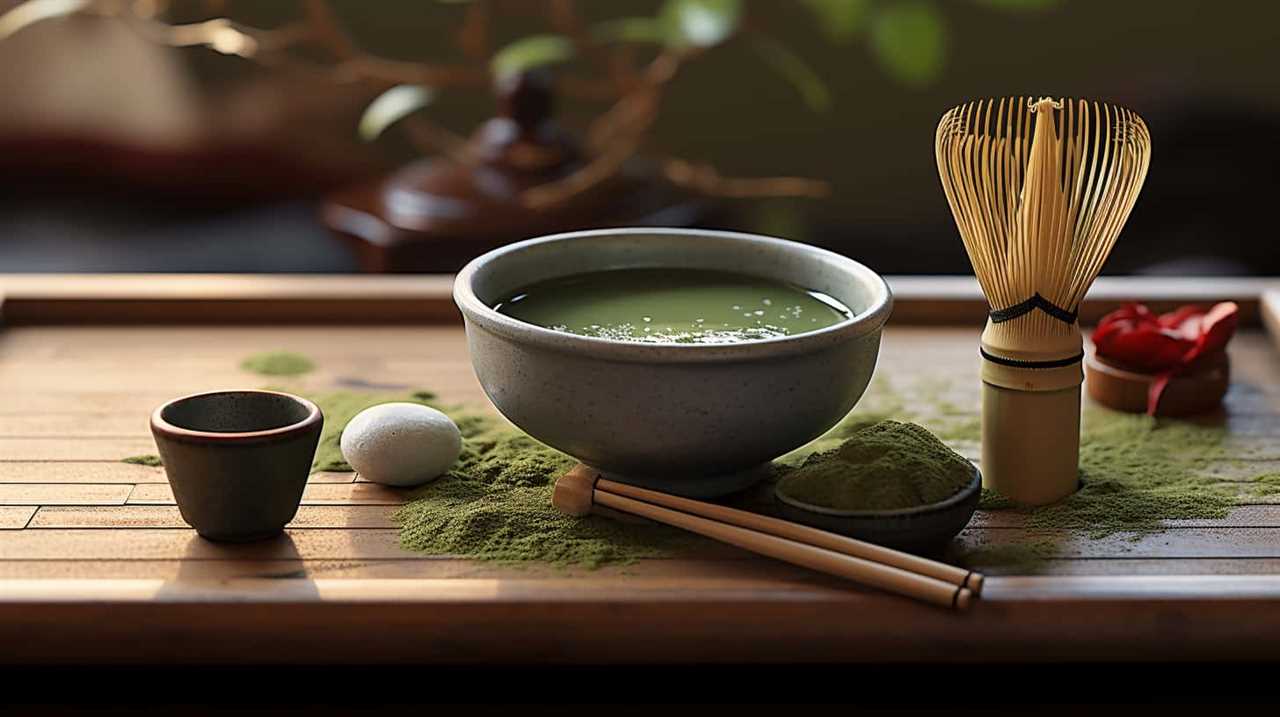
Justin is a seasoned author, coffee and tea enthusiast, and an essential member of the Cappuccino Oracle team. With a keen appreciation for the complexities of coffee, coffee alternatives, and tea, Justin has dedicated his professional career to exploring these realms and sharing his insights with readers worldwide.
Justin’s immersion in the world of coffee, coffee alternatives, and tea began at a young age, kindling a passion that extended beyond mere consumption. This love for these beverages led him to combine his talent for writing with his devotion to coffee and tea, bringing him to Cappuccino Oracle as a dedicated author.
Matcha
Unveiling The Mysteries Of Matcha: Insights On Its Origins, Production, And Quality

Have you ever been curious about the mysteries behind the rich and natural flavors of matcha? If so, get ready to join me on an adventure as we uncover the secrets of matcha, delving into its origins, production, and quality.
As a lover of all things tea, I have delved deep into the world of matcha, immersing myself in its rich history and intricate production process. From the shade-grown tea leaves to the meticulous grinding technique, every step is a labor of love that culminates in the velvety smooth powder we know as matcha.
Join me as we unravel the secrets behind this ancient Japanese tradition and discover why quality is key when indulging in this verdant elixir. We’ll explore the nuances of flavor, the importance of sourcing, and even delve into the fascinating world of other tea varieties.
So grab a cup, sit back, and let’s dive into the captivating world of matcha.
Key Takeaways
- Matcha tea is made from powdered green tea leaves and has a long and labor-intensive production process.
- Premium matcha is made from the first harvest in early spring, using the top 3 sprouts of the tea plant and ground tencha leaves.
- Cheaper matchas may skip some steps in the production process and are more suitable for matcha lattes.
- High-quality matcha is recommended for sparing consumption, as it has a smoother flavor and more health benefits compared to cheaper matchas.
What is matcha?
I’ve learned that matcha is a powdered green tea made from special tea leaves that are shaded before harvest, and it has a long and labor-intensive production process.
There are different types of matcha available, but the premium matcha is made from the first harvest in early spring, using only the top 3 sprouts of the tea plant. The leaves are then steamed, dried, and have their stems removed before being ground into a fine powder using a specialized mill made of granite.
It’s important to note that high-quality matcha is recommended for sparing consumption, as it has a complex production process that results in a smooth flavor. Matcha also offers various health benefits, such as being rich in antioxidants, boosting metabolism, and improving mental alertness.
Production process
The matcha production process involves shading the tea leaves before harvest and selecting the top three sprouts of the tea plant for premium matcha. Shading is a technique used to enhance the flavor and quality of the tea leaves. By covering the tea plants with shade, the leaves produce more chlorophyll and amino acids, resulting in a vibrant green color and a rich, umami taste.
After the shading period, only the top three sprouts of the tea plant are carefully handpicked for premium matcha. These selected leaves, known as tencha leaves, are then steamed, dried, and have their stems removed.
Finally, the tencha leaves are ground into a fine powder using a specialized granite mill. This process results in the smooth and concentrated matcha powder that we enjoy.
Quality and consumption
Let me tell you, indulging in high-quality matcha is like sipping a vibrant green elixir that awakens your taste buds and nourishes your body with its rich flavor and numerous health benefits. Matcha’s health benefits are truly remarkable. Packed with antioxidants, vitamins, and minerals, matcha is known to boost metabolism, enhance focus and concentration, and strengthen the immune system.
But not all matcha is created equal. Different grades of matcha exist, ranging from ceremonial grade to culinary grade. Ceremonial grade matcha is made from the highest quality tencha leaves and has a smooth, vibrant green color and a delicate, umami flavor. It is best enjoyed on its own, whisked with hot water.
On the other hand, culinary grade matcha is more affordable and is suitable for making matcha lattes, smoothies, and baked goods. Although it may have a slightly bitter taste and a duller color, it still provides health benefits.
So, whether you choose to indulge in high-quality ceremonial grade matcha or opt for the more affordable culinary grade, incorporating matcha into your routine is a delicious way to reap its health benefits.
Frequently Asked Questions
What are some popular ways to enjoy matcha besides drinking it as tea?
Besides drinking matcha as tea, some popular ways to enjoy it include indulging in matcha desserts like matcha ice cream, matcha cake, and matcha cookies. Additionally, matcha smoothies are a refreshing and healthy option.
Are there any specific health benefits associated with consuming matcha?
I’m no expert, but matcha is said to have potential health benefits. Some claim it can aid in weight loss due to its high antioxidant content and metabolism-boosting properties. However, more research is needed to confirm these claims.
How does the quality of matcha affect its flavor and overall experience?
The quality of matcha directly affects its flavor and overall experience. Higher quality matcha, made from carefully selected leaves and processed with precision, offers a smoother and more vibrant flavor, while lower quality matcha may have a less appealing taste and color.
Can matcha be used in cooking or baking?
"Where there’s matcha, there’s a way! Matcha can be used in a variety of cooking and baking recipes, adding a vibrant green color and a unique earthy flavor to dishes like matcha desserts."
Are there any specific tips or techniques for properly preparing matcha tea at home?
To properly prepare matcha tea at home, start by sifting the matcha powder to remove any clumps. Then, choose water at around 175°F to 180°F for the best flavor. Gradually add water to the matcha and whisk in a "W" or "M" motion until frothy. Enjoy!
Conclusion
In conclusion, matcha tea is not just a beverage, but a rich and fascinating tradition that has evolved over centuries.
From its origins in Japan to its intricate production process, matcha is a labor of love.
The quality of matcha is crucial, as the steps taken in its production directly impact its flavor and aroma.
Whether you’re a matcha connoisseur or a beginner, there is a matcha tea out there for you.
So, why not indulge in a cup of this vibrant green elixir and experience the magic of matcha for yourself? It’s a journey worth embarking on!
Arf, an author and an innovative enthusiast of coffee, coffee alternatives, and tea, plays a crucial role as a contributor to the esteemed Cappuccino Oracle platform. Renowned for his curiosity and passion for these captivating beverages, Arf has carved out a unique space for himself in the world of exploration and writing. He realized that coffee, coffee alternatives, and tea are not mere drinks to keep one awake, but universes of flavors and stories waiting to be explored.
Arf’s articles for Cappuccino Oracle blend meticulous research with personal experiences, providing readers with an in-depth understanding of various types of coffee, coffee alternatives, and tea, along with their unique characteristics, cultures, and histories. His honest reviews and engaging narratives guide readers on their own journeys, helping them discover their preferences and find their perfect brew.
Matcha
Unveiling The Truth Behind Starbucks’ Matcha: A Disappointing Blend

Being a lover of tea, I was eager to sample Starbucks’ matcha beverages, anticipating a flavorful and genuine taste. However, to my dismay, I found that it was a subpar mixture of inexpensive green tea powder and an excessive amount of sugar. This was a stark contrast to the customary matcha experience that I had grown accustomed to.
The use of low-quality matcha by Starbucks is driven by the need for mass production and a consistent taste across all locations. But in this pursuit, they have sacrificed the true essence of matcha. Authentic matcha production involves meticulous steps to ensure a high-quality and flavorful product, steps that Starbucks seems to skip.
The result is a matcha latte packed with 32 grams of sugar, equivalent to a can of soda, and a whopping 240 calories. It’s time to unveil the truth behind Starbucks’ matcha and explore better options for a truly satisfying tea experience.
Key Takeaways
- Starbucks uses a cheap green tea powder for their matcha drinks, which may not even be considered matcha.
- The cheap matcha powder is mixed with a lot of sugar, negating the health benefits and undermining the quality of the tea.
- Starbucks’ matcha latte contains a high amount of sugar, similar to a can of soda, and has a significant number of calories.
- To have a better matcha experience, it is recommended to explore premium, first harvest matcha made by talented farmers in Japan and to try different matcha options to find preferred taste.
What is Starbucks Matcha?
Starbucks Matcha is a cheap green tea powder mixed with a high amount of sugar, which not only undermines the health benefits of matcha but also fails to deliver the natural, great-tasting flavor of authentic matcha tea.
The ingredients used in Starbucks matcha include low-quality green tea powder that is likely produced on a large scale. Unlike traditional matcha production methods, Starbucks skips certain steps to save time and money. These steps, such as shading the tea plants to reduce bitterness and selecting the top leaves for their flavor and nutrients, are crucial in creating high-quality matcha.
Instead, Starbucks opts for a blend of cheap green tea powder mixed with sugar, resulting in a dull and bitter flavor. This disappointing blend of ingredients does not live up to the standards of true matcha tea.
Quality vs. Cheap Matcha
Indulging in high-quality matcha is like savoring a delicate melody that dances on your taste buds, while settling for cheap matcha is akin to a discordant symphony that leaves a bitter aftertaste. When it comes to matcha, quality matters. Traditional matcha production is an art that requires time, patience, and attention to detail. The importance of shading the tea plants, selecting the top leaves, and using a stone mill to grind the leaves into a fine powder cannot be overstated. These steps not only enhance the flavor but also preserve the health benefits of matcha. High-quality matcha is rich in antioxidants, boosts metabolism, and promotes a sense of calm. On the other hand, cheap matcha often lacks these qualities as it skips crucial steps and is mixed with sugar and other additives. Don’t settle for a subpar matcha experience; choose high-quality matcha for its exceptional taste and health benefits.
| Traditional Matcha Production |
|---|
| Shading the tea plants |
| Selecting the top leaves |
| Grinding with a stone mill |
The importance of traditional matcha production cannot be overstated. These steps not only enhance the flavor but also preserve the health benefits of matcha. High-quality matcha is rich in antioxidants, boosts metabolism, and promotes a sense of calm. On the other hand, cheap matcha often lacks these qualities as it skips crucial steps and is mixed with sugar and other additives. Don’t settle for a subpar matcha experience; choose high-quality matcha for its exceptional taste and health benefits.
Recommendations for Better Matcha
Exploring different matcha options can lead to a better matcha experience. When it comes to matcha, not all options are created equal. While Starbucks may offer a convenient matcha latte, there are alternative options that provide a more authentic and higher quality experience.
Premium matcha, specifically first harvest matcha, is made by talented farmers in Japan and can be enjoyed plain, without the need for excessive sugar or additives. By choosing premium matcha, you can reap the full benefits that matcha has to offer, such as its high antioxidant content and potential health benefits.
Additionally, exploring different types of matcha, such as Japanese black tea, can expand your taste palate and introduce you to new and exciting flavors. So, why settle for a disappointing blend when there are better matcha options out there waiting to be explored?
Frequently Asked Questions
How is Starbucks matcha different from traditional matcha?
Starbucks matcha differs from traditional matcha in terms of quality and taste. One interesting statistic is that Starbucks’ matcha latte contains 32 grams of sugar, similar to a can of soda, which undermines the health benefits of matcha.
What are the health benefits of matcha and how do they differ between Starbucks matcha and premium matcha?
The health benefits of matcha include high levels of antioxidants, increased energy, and improved focus. However, Starbucks matcha quality is compromised due to the use of cheap powder mixed with sugar, negating these benefits.
Can you customize the sweetness level of Starbucks matcha drinks?
Yes, you can customize the sweetness level of Starbucks matcha drinks. They offer popular matcha drink variations like matcha latte and matcha frappuccino, allowing customers to choose the amount of sweetener they prefer.
Are there any alternative options for matcha drinks at Starbucks?
Yes, there are alternative options for matcha drinks at Starbucks. However, it’s important to note that the taste may not be comparable to traditional matcha. Exploring different matcha options and Japanese black tea can provide a better experience.
What are the steps involved in producing high-quality matcha and how does Starbucks’ matcha production differ?
Starbucks’ matcha production process differs from traditional matcha production in Japan. High-quality matcha involves shading the tea plants, selecting the top leaves, steaming, drying, and grinding them. However, Starbucks skips these steps, resulting in a lower quality and less authentic matcha experience.
Conclusion
In conclusion, after delving into the truth behind Starbucks’ matcha, it’s clear that their blend falls short of expectations. The use of cheap green tea powder mixed with excessive sugar dilutes any potential health benefits and fails to deliver an authentic matcha experience.
To truly enjoy the rich and flavorful taste of matcha, it’s recommended to explore premium, first harvest options crafted by skilled Japanese farmers. Don’t settle for subpar matcha; treat yourself to a tea experience that’ll leave your taste buds dancing with delight.
Arf, an author and an innovative enthusiast of coffee, coffee alternatives, and tea, plays a crucial role as a contributor to the esteemed Cappuccino Oracle platform. Renowned for his curiosity and passion for these captivating beverages, Arf has carved out a unique space for himself in the world of exploration and writing. He realized that coffee, coffee alternatives, and tea are not mere drinks to keep one awake, but universes of flavors and stories waiting to be explored.
Arf’s articles for Cappuccino Oracle blend meticulous research with personal experiences, providing readers with an in-depth understanding of various types of coffee, coffee alternatives, and tea, along with their unique characteristics, cultures, and histories. His honest reviews and engaging narratives guide readers on their own journeys, helping them discover their preferences and find their perfect brew.
Matcha
The Ultimate Guide To Using Chashaku: Your Matcha Essential

Being a lover of matcha, I am aware that the crucial factor in achieving the perfect matcha bowl is the equipment we utilize. When it comes to preparing matcha, there is one tool that is particularly essential: the chashaku.
This bamboo spoon, with its elegant design and precise measurements, is the secret weapon of matcha lovers worldwide. In this ultimate guide, I will take you on a journey through the history and evolution of the chashaku, and show you how to use it like a pro.
From its origins as a metal or ivory scoop to its modern-day incarnation in bamboo, the chashaku has come a long way. With its 48° bend and 18mm length, it effortlessly scoops the perfect amount of matcha from its container.
So grab your chashaku and get ready to elevate your matcha game to new heights. Let’s dive in and discover the wonders of this matcha essential.
Key Takeaways
- Chashaku is a bamboo spoon used to scoop matcha powder in the Japanese tea ceremony and by matcha lovers worldwide.
- Chashaku is one of the three important tea utensils used in the tea ceremony and is about 18mm in length with a 48° bend at the end for scooping.
- Chashaku is made of bamboo to avoid negative reactions with matcha powder and is a great measurement tool for matcha powder.
- Two scoops of chashaku is the standard amount for a bowl of matcha tea, and it is easy to maneuver in matcha tins or natsume due to its small size.
What is Chashaku?
Chashaku is a bamboo spoon used to scoop matcha powder, and it’s one of the three important tea utensils used in the Japanese tea ceremony.
Made from a single piece of bamboo, this elegant tool has a long history dating back to the Muromachi period in Japan. Originally crafted from metal or ivory, chashaku evolved to be made of bamboo due to its natural properties and to avoid any negative reactions with matcha powder.
The design of chashaku is both functional and beautiful, with a length of about 18mm and a 48° bend at the end for easy scooping. There are different styles of chashaku scoops, each with its own unique shape and characteristics. The back of the chashaku has a rough texture, while the face is smooth and sleek.
Whether you’re a matcha lover or a tea ceremony enthusiast, using a chashaku adds a touch of authenticity and tradition to your matcha preparation.
History and Evolution
During the Muromachi period in Japan, the chashaku spoon evolved from being made of metal or ivory to its current bamboo form, which is about 18mm in length and has a 48° bend at the end for easier scooping. The history and evolution of the chashaku is a testament to its significance in Japanese tea ceremonies and its cultural importance in matcha preparation.
| The significance of chashaku in Japanese tea ceremonies | The cultural importance of chashaku in matcha preparation |
|---|---|
| Chashaku is one of the three important tea utensils used in the tea ceremony. | Chashaku is a great measurement tool for matcha powder. |
| Chashaku originated in Japan during the Muromachi period. | Chashaku’s small size allows for easy maneuvering in matcha tins or natsume. |
| Originally made of metal or ivory, chashaku evolved to be made of bamboo. | Chashaku is made from a single piece of bamboo and shaped with a bend for the scoop. |
| Chashaku is made of bamboo to avoid negative reactions with matcha powder. | The back of chashaku has a rough texture, while the face is smooth and sleek. |
The chashaku’s role in Japanese tea ceremonies cannot be understated. It is one of the three essential utensils used in the tea ceremony, alongside the chawan (tea bowl) and chasen (tea whisk). The chashaku’s small size and precise measurement make it the perfect tool for scooping matcha powder. Its evolution from metal or ivory to bamboo shows the cultural importance placed on this utensil. The chashaku’s design, with its gentle bend and smooth face, allows for easy and graceful scooping of matcha. Using the chashaku is not only practical but also a way to honor the centuries-old tradition of matcha preparation.
How to Use Chashaku
To use the chashaku, I simply hold it like a pencil and dip the scoop into the matcha container. Then, I carefully lift the chashaku scoop out and place it over the matcha bowl to dump the powder.
It’s a simple and elegant technique that ensures the perfect amount of matcha every time.
But did you know that there are alternative ways to use the chashaku? Some matcha lovers prefer to use a teaspoon or a regular spoon to scoop their matcha powder. While these alternatives may work in a pinch, they don’t offer the same precision and authenticity as the chashaku.
The chashaku’s unique design and size make it the ideal tool for measuring matcha powder. Plus, using the chashaku adds a traditional touch to the matcha preparation process, enhancing the overall experience.
So why settle for anything less? Embrace the chashaku and elevate your matcha game to the next level.
Frequently Asked Questions
What are the different types of materials used to make chashaku besides bamboo?
There’s something truly magical about the chashaku, the bamboo spoon that gracefully scoops matcha powder. While bamboo is the traditional material, chashaku can also be made from metal or ivory, although these alternatives are less common.
Can chashaku be used to scoop other powders besides matcha?
Yes, chashaku can be used to scoop other powders besides matcha. However, it is primarily designed for scooping matcha powder and is most commonly used in Japanese tea ceremonies. To properly clean and care for a chashaku, it is recommended to wipe it with a dry towel or tissue to avoid water damage. The chashaku is a versatile tool with different uses in the tea ceremony, making it an essential item for matcha lovers.
How long does a chashaku typically last before it needs to be replaced?
A chashaku typically lasts for a long time, but the lifespan can vary depending on the material. Bamboo chashaku is the most common and durable option, while metal or ivory may wear down over time. Proper care involves cleaning with a dry towel or tissue to avoid water damage.
Can chashaku be used with different types of matcha bowls or is it specific to a certain style?
Absolutely! Chashaku can be used with various types of matcha bowls, adapting to different styles. Its small size and unique design make it perfect for scooping matcha powder and adding a touch of elegance to your matcha preparation.
Are there any alternative utensils that can be used in place of chashaku for scooping matcha powder?
Yes, there are alternative utensils for scooping matcha powder, such as a teaspoon or a small spoon. However, using a chashaku has its benefits. Its unique design allows for precise measurements and easy maneuvering in matcha tins.
Conclusion
In conclusion, using chashaku isn’t just a practical way to measure and scoop matcha powder, but it’s also an essential tool for embracing the art and tradition of the Japanese tea ceremony.
While some may argue that using a regular spoon can achieve the same result, chashaku offers a unique experience that connects us to centuries of tea culture. Imagine holding the slender bamboo spoon, feeling the weight of tradition in your hand, and delicately scooping the vibrant green matcha powder.
It’s a sensory journey that brings us closer to the beauty and mindfulness of matcha preparation. So, embrace the chashaku, and let it elevate your matcha experience to new heights.
Arf, an author and an innovative enthusiast of coffee, coffee alternatives, and tea, plays a crucial role as a contributor to the esteemed Cappuccino Oracle platform. Renowned for his curiosity and passion for these captivating beverages, Arf has carved out a unique space for himself in the world of exploration and writing. He realized that coffee, coffee alternatives, and tea are not mere drinks to keep one awake, but universes of flavors and stories waiting to be explored.
Arf’s articles for Cappuccino Oracle blend meticulous research with personal experiences, providing readers with an in-depth understanding of various types of coffee, coffee alternatives, and tea, along with their unique characteristics, cultures, and histories. His honest reviews and engaging narratives guide readers on their own journeys, helping them discover their preferences and find their perfect brew.
-

 Americano3 weeks ago
Americano3 weeks agoHow to Make Americano With Moka Pot
-

 Americano4 weeks ago
Americano4 weeks agoHow to Make an Americano in a French Press
-

 Americano6 days ago
Americano6 days agoHow to Make Korean Iced Americano
-

 Americano3 weeks ago
Americano3 weeks agoHow to Make Iced Americano With Instant Coffee
-

 Americano3 weeks ago
Americano3 weeks agoWhat to Add to an Americano at Starbucks
-

 Americano4 weeks ago
Americano4 weeks agoHow to Make Americano With a Nespresso Machine
-

 Americano3 weeks ago
Americano3 weeks agoHow to Make Americano With Bialetti
-

 Americano3 weeks ago
Americano3 weeks agoHow to Make Dutch Bros Americano

















